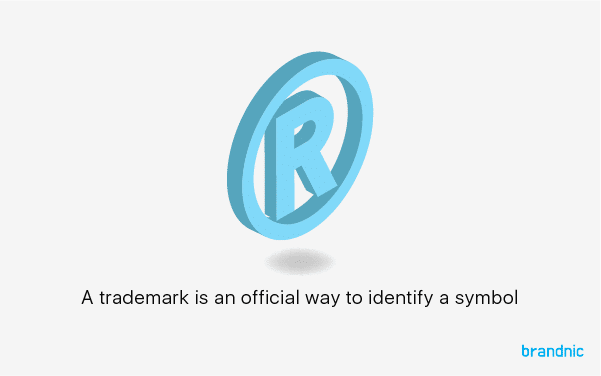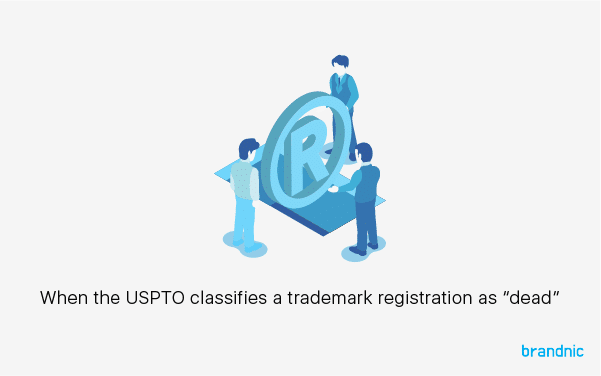Read Time: 11 minutes
What is a trademark?
First things first, you must be aware of the definition of a trademark before claiming one yourself. A trademark is an official way to identify a symbol, word or words which represents a company or entity.
Trademark basically helps distinguish specific products from the goods of others. It is also called servicemark when it involves services.
The reason why it was created is simple:
No consumer confusion! So you can build your business in a fast and safe way.

Understanding the trademarks and their types.
Here are some of the main benefits of federal trademark registration:
- Lets other companies know that you are using it.
- It helps protect against registrations of similar marks.
- It makes hiring easier.
- It allows the registrant to sue in a federal court if necessary.
- This leads to higher traffic on a website.
Now we know that a trademark is the legal form of a brand, but sometimes they are classified as abandoned or dead.
What does a dead trademark mean?
Trademarks are usually to be registered in a trademark office such as the United States Patent and Trademark Office (USPTO). It is considered dead when this type of trademark office doesn’t recognize it anymore.
More about all trademark types.
Luckily, this doesn’t mean it is lost forever, an abandoned trademark is available for use by other individuals or companies under the correct circumstances. Nevertheless, the original registrar won’t be able to seek protection for that trademark.
The process can be more complex than people think, in fact, the registrant may face cases such as a trademark opposition or a trademark infringement before offices such as USPTO decides to take action.
Identifying an abandoned trademark
At first, it is actually not necessary to register a trademark, you can acquire trademark rights through regular usage of your business in commerce.
Trademarks don’t have an expiration date and they are very useful to protect a company that is growing potentially fast.
There are many reasons why a trademark can be considered abandoned. Once the registration application is started, a trademark can be canceled under some reasons:
- The applicant stops responding to the trademark office.
- Lacking the necessary paperwork
- The application is incomplete.
Yet, it is common that these registrations fail during their first steps, as a result, the applicant is able to choose whether to continue with the process or not. This is when the confusing part starts!
A common mistake is to think that a canceled trademark is immediately ready to be used by someone else.
However, most of the cases show that the owner is still using it and may have trademark rights, but we’ll continue with this in a few moments.
In normal circumstances, a registered trademark will only need a declaration of continued use every five and ten years after the first registration.
It’s the easiest way to keep it “alive”, however, it is also a common reason to fail a trademark registration and being classified as “abandoned”. It doesn’t stop there, vintage trademarks can be the result of many other factors.
4 main reasons why the trademark may become dead

Still a chance to use your trademark – explained.
1. Improper licensing
A mark holder is in charge of supervising his franchise in order to verify if the licensee produces the exact good that it is required. That is to say, quality control and supervision programs (which are essential for store chains and large companies)
A trademark can be declared dead by some courts if the owner fails to control his company.
2. Genericity
It’s not the first time that an original term is used to describe a general item or service once it has gained enough popularity. Unfortunately, it means that the trademark owner has failed to keep the use of its mark limited.
Genericity means that a trademark has lost its meaning and its services or products are not related to the original business anymore.
For example, the term “dry ice” was once registered by the Dry Ice Corporation of America in 1925, but it is now considered a genericized trademark. Find how you can trademark a phrase on your own on the link.
3. Assignments lacking an accompanying sale
A mark holder is able to assign his ownership rights to another party.
Yet, it is necessary a full sale of assets to avoid killing the trademark.
The reason is simple, the owner shouldn’t sell only the trademark because it will no longer represent the original product it was associated with.
4. Abandonment
A trademark is considered abandoned when a mark holder stops using it for commercial purposes.
An owner can keep his trademark rights as long as they continue to pay the licensing fees and avoid being inactive for three consecutive years.
Owners can still save their trademarks if they succeed to demonstrate that they intend to use them after some time. Mark holders can express abandonment in a trademark office even though the rights of the owner won’t stop to exist after the mark is considered dead.
How to revive your own vintage trademark
You are getting into business again and you would like to claim for your old trademark that now has been declared “dead”. Is it possible to save it from abandonment? You may be happy to know that you still have a chance as long as you follow the right steps.
Identify why your trademark rights were taken from you
We mentioned several reasons above that can help you understand why you are no longer the mark holder. It is important to know that you have better possibilities of having your trademark back if the reason is abandonment.
Understand the current status of your trademark
Go to the trademark office where you registered your mark such as USPTO and perform deep research to find out whether your trademark is being used by other businesses or it is still considered abandoned.
If it is still marked as “dead”, you are very likely to have it back in no time by proving you intend to resume it.
Nevertheless, if another company has started to use it after a three-year period of abandonment, you will have to buy it from the new owner.

Reviving your trademark.
The other option is to consult with an intellectual property law expert to start a more complex legal argument and save your old trademark. However, it is a process that requires more paperwork and specialized attorneys.
Use your trademark again
If you were lucky enough to complete step two successfully, you can now enjoy using the trademark. However, a judge will decide whether you will be given the legal rights over your trademark again.
Don’t forget to register
In order to avoid future disputes, you should register your trademark again. This is highly recommended because you may not be aware of how your mark was used while it was abandoned.
I want to acquire a dead trademark – what should I do?
When the USPTO classifies a trademark registration as “dead”, it indicates that the registrant failed in maintaining the registration in the first place.

When USPTO – consider a trademark as a dead trademark.
Following this, we often receive many common questions such as:
Can I register a trademark if it is dead?
It is possible to bring back to life another’s an abandoned trademark, but it’s also possible that the original registrant still owns some of the common-law trademark rights as we mentioned above.
This is when a dead registration can actually be considered a live trademark which means it is not available to be registered again.
The process of claiming a dead trademark also depends on consumer recognition since the more successful it was, the more difficult it may be to acquire it.
Here you have a few useful steps you can follow to claim a vintage trademark.
1. Perform a trademark research
The first steps may be similar to the ones we talked about previously, but they are crucial to creating your trademark plan.
Once you find out that the trademark you wish to acquire belonged to someone else, you should determine its current status. A useful tool can be alive/dead indicator trademark which will let you know whether the vintage trademark is still in use or not.
How about if the trademark is still active?
If your Google trademark search shows that someone is using the trademark you want, your only option is to buy the rights from the current owner.
We highly advise conducting a global search if you’d like to use the trademark worldwide. This can be a great option to determine its status in other countries.
Live/dead indicator trademark
You may use USPTO to conduct a search online as well as the Trademark Electronic Search System (TESS). This database allows you to see which trademarks can be claimed through its live/dead categories. For instance,
The live category is divided into other two subcategories:
- The trademark application is not issued, but it is considered active. You can only find a serial number since there isn’t a registration number.
- Federal trademark rights can be asserted and the mark is valid as long as there is a registration number.
On the other hand, the “dead” category also involves two subcategories.
- Lack of registration number since the applicant never completed the application process.
- There was a registration number but resulted in a canceled trademark due to abandonment. The registration isn’t valid anymore and federal rights can’t be used. The original owner can only claim state trademark rights through common law.
2. Apply for an Intent-to-use file
Everything will be more professional if you follow the legal process that trademark offices such as USPTO ask for.
This is an important step if you determine that vintage trademark is not being used by someone and you’d like to proceed to claim it.
File an application form so you can establish an official date confirming you registered the trademark. It is crucial to follow this step before you start using the mark so you can have complete rights over the products and services you offer. Moreover,
Disputes related to trademarks are very common and most of them occur due to lack of paperwork and evidence.
The sooner you demonstrate the mark is yours, the safer you will be. For example:
Most trademark applications require genuine intentions to use the mark for a long period of time. This intent is demonstrated by filing all the requirements that the intent-to-use application asks for.
What requirements should I present?
They are very likely to ask for any activities that show your business as a good candidate to boost the trademark faster. These activities include development activities, market research or any other manufacturing activities.
3. Time to register the trademark
After completing phase two, you may want to register your new mark so you can avoid future disputes and affirm your ownership of the trademark.
You can now begin any commercial activities using the trademark. However, trademark offices such as USPTO will let everyone know about your purchase in order to give another mark holder the chance to oppose your rights.
It may sound unnecessary, but it is part of the legal process USPTO has to follow. As a result, the previous owner is allowed to start a legal challenge against you by using the intellectual-property law.
A life-saving tip would be to hire an attorney so you can build a legal defense against these challenges as step four indicates.
Don’t worry! Most of these cases lack clear standards and a lot of evidence is required to prove whether or not the trademark was abandoned by the original owner.
4. Be aware of how the original owner may want his trademark back
Learning the ways how the initial owner can use common-law rights against you is the first step to prevent losing your new trademark. The common law derives from judicial and custom precedent, it doesn’t involve statute.
In other words …
It can protect mark holders even if there is an absence of federal trademark registration. This is the most common option previous owners use to mount a challenge to a trademark application. Is there a good alternative to avoid this?
Protect your trademark by using it!
You still maintain some trademark’s ownership, therefore if you show you are using it on your products, you will have more evidence that the trademark is yours.
Choose what it is truly worth to you
Claiming for an abandoned trademark can be a long way, but it brings many benefits to your company. It is essential to pick a trademark that you feel identified with so you do the proper research before making it part of your plan.
Determine the importance of a mark by asking yourself some questions:
- Will this trademark provide more traffic for your company?
- Is this trademarkable to complement your marketing plan?
- Are you willing to face the risks that using this mark may bring?
Potential risks when acquiring abandoned trademark
Don’t take it easy! A trademark that looks available may actually lead to complications during the registration process. Most risks only occur due to a lack of research. For instance:
- Live trademarks – using a trademark that is classified as “live”. Moreover, the current owner is the only person who can legally use the mark.
- Widely recognized trademarks – another party may be using the mark even if a trademark appears as “dead” which makes it more difficult for the public to relate it your products/services.
- Being sued by the original business – this is not a common thing, you should make sure to learn who the previous owner was and determine his reasons for abandonment. Keep regular research on your vintage trademark. We recommend performing regular searches in order to ensure that your trademark isn’t being used for other commercial purposes.
BONUS – Using USPTO to check the meanings of abandonment
We’ve talked about doing some research before buying a dead trademark as well as using USPTO’s database to check the status of the mark, but how about if you could also check the reason why it was abandoned?
It may sound useless at first because the trademark is considered “dead” either way. Yet, understanding how the trademark was abandoned will give you a good hint of whether to claim for it or not.

Checking the reason behind the trademark being abandoned.
Start your detective work checking the status of the mark (TARR) at USPTO. Then you can access to Trademark Document Retrieval (TDR) to collect more evidence about the trademark you are looking for.
You really want to avoid claiming for a mark that had many examiner objections during their application process.
In other words, an examiner had a good reason to decide why the mark shouldn’t be registered which lets you know you are trying to buy a trademark that would probably cause you trouble.
There are other common cases where the trademark was simply abandoned or canceled due to a lack of paperwork. These are the trademarks you may want to apply for since it’s less likely that you’ll have to face a previous owner ready to fight for his vintage trademark.
Is there an annual fee after a trademark is approved?
A common question we often receive is whether a mark holder has to pay a fee for maintaining a trademark. People often worry about this because not paying the requested fees can lead to the cancelation of the trademark.
There is indeed an annual fee even for renewals and it starts since the very moment the trademark is issued. Nonetheless, the maintenance schedule is completely related to the rules where it was registered.
For example, the USPTO requires a file of “continued use” after 3 or 6 years in order to avoid being canceled.
The process continues after a few years and so on. It all depends on the country where it was registered since there are trademark offices that accept installments like the case of the Japanese trademark office.
Brandnic helps you with the trademark certification
We love offering an attractive business name in a quick and safe way. Brandnic has the best options for you! With every purchase, you get a domain name, a unique logo design, free logo revisions, common law trademark, AND trademark monitoring.
We help you with your first ideas in order to have an attractive and memorable business name.
Brandnic also offers customer support which provides basic functioning to ensure a fast response to all of our customers. We believe customer satisfaction as our key value.
















